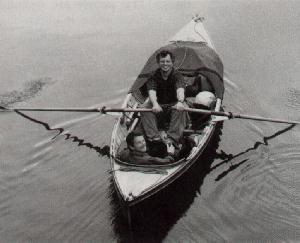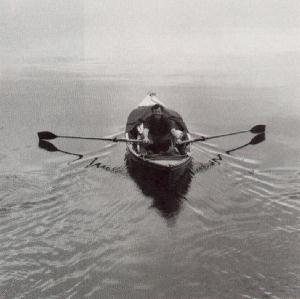

 |
 |
| Peter sets off on an early summer morning with Brian Daugherty and his dog, Max, to row 70 miles from Junea to Glacier Bay - a one to five-day trip, depending on the seas and the weather. (Nan Elliot) |
| eastern Gulf of Alaska to Lituya Bay, which
has a turbulent and tragic history, a few thought he might die, but no one advised against
it. Along 100 miles of stormy coastline in the Gulf of Alaska from Cape Spencer to Yakutat, Lituya Bay is the only "safe" harbor from the storms. In 1786, the first white man to explore it, a Frenchman named La Perouse, lost two boats "and 21 brave mariners" in the wild waters at the entrance to the bay. The tides are high, the entrance is very narrow, and the |
whole North Pacific Ocean flows in and out
twice a day, creating serious navigational hazards. In 1958, a huge mass of rock and ice
split off from the Fairweather Mountain Range and fell into the bay, creating a wave 1,700
feet high. Three fishing boats were in the bay at the time. One was smashed. Two
miraculously survived, one surfing the wave over the spit of land into the Gulf. Subsequent scientific study showed that Lituya Bay, which lies on the Fairweather fault line, has evidence of such devastating tidal waves every 25 years or so. |
As one scientist said, it only needs a volcano
to make it a perfect microcosm of geologic hazards on the Pacific coast. Undaunted, Peter made the journey with a friend who had never rowed before. Rounding Cape Spencer, they got blown six miles out to sea by powerful winds roaring down the Brady Glacier. But they had more fear of bears than wild seas and slept anchored out in the boat more than once. It was May and the snow was still down on the ground. It was particularly cold. This was an endurance trip. But |
| Next |